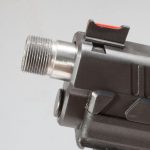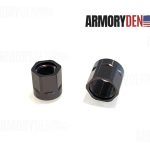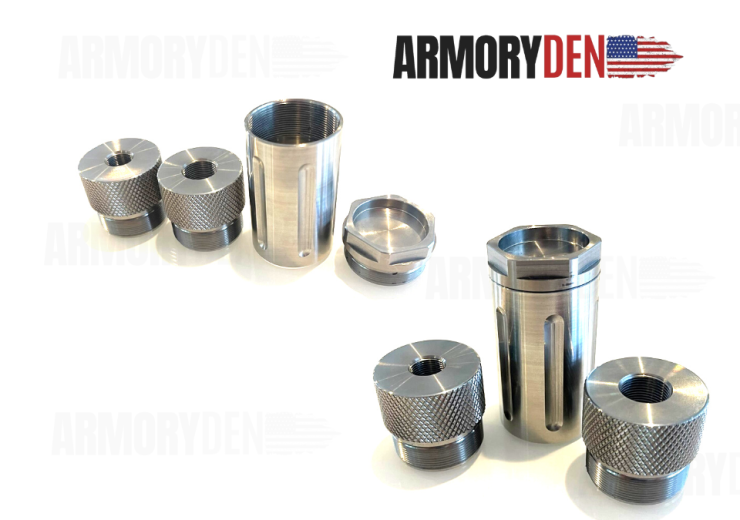
What is a D Cell Solvent Trap, and How is it Different from a C Cell Solvent Trap?
It’s common to mess up your cleaning space when cleaning your firearm. For example, the cleaning solvent used in cleaning the firearm bore can drip onto the floor and make the whole place untidy. Sadly, it doesn’t just stop there. When disposed of improperly, these solvents can cause danger to the environment because of the substances used in making them.
To combat this issue, many firearm owners have turned to the use of solvent traps as a solution to prevent messing up their cleaning space while also protecting the environment. But like most firearm accessories, these traps come in various sizes and are often categorized as D cell or C cell solvent traps.
Here, we’ll look at D cell solvent traps, one of the most widely demanded solvent traps, and how firearm owners in need of a solvent trap can differentiate it from the C cell solvent trap. That way, firearm owners looking to purchase a solvent trap can easily identify the most suitable product for their firearm.
But first, here’s a brief overview of solvent traps for those just hearing about it.
What are solvent traps?
Solvent traps are threaded accessories used in catching or trapping firearm cleaning solvent during cleaning operations. The excess solvent used in cleaning the firearm drips into the solvent traps and is finally trapped in the storage cups. This trapped solvent can either be recycled for use by the owner or disposed of properly where it won’t cause harm to the environment.
Why you need a solvent trap
There are so many reasons you need a solvent trap, but here are a few.
- Environmental safety: Firearm cleaning solvents are mostly made of carbon compounds such as acetylene or toluene. These carbon compounds increase our carbon footprint on the earth when disposed of carelessly. Solvent traps help prevent this from happening by trapping these harmful compounds so that they can be disposed of properly.
- Minimize waste: Firearm cleaning solvents are expensive, and it would be a shame to see the solvent go to waste after one cleaning process. That’s where solvent traps come in. Solvent traps help prevent the waste of the cleaning solvent by trapping them so that they can be subsequently recycled and reused in the future.
- Human safety: Cleaning solvents are not just dangerous to the environment, but they can also cause harm to people. When fumes from firearm cleaning solvents are allowed to escape into the atmosphere, they create a toxic atmosphere for people within the area, which can be dangerous for people with respiratory problems.
Now that you’ve known what a solvent trap is and the importance of having one, let’s talk about one of the most widely demanded solvent traps.
A D cell solvent trap is a solvent trap that has an outer diameter of 1.5″ and an internal diameter of 1.375″. D cell solvent traps are available in 5/8 x 24″ and 1/2 x 28″ thread protectors. This makes it especially important to check the thread pitch of your firearm before buying a D Cell solvent trap.
That way, you won’t end up buying a solvent trap that is unsuitable for your firearm. In case you’re wondering, the D in the name is a letter used to specify the diameter of the solvent trap. Now, although most D cell solvent traps typically possess an outer diameter of 1.5″, this is not always the case.
For example, Armory Den’s D cell solvent traps come with an outer diameter of 1.75″ while maintaining the typical internal diameter of 1.375″. Even though this is specific to Armory Den solvent traps, it does not affect the functionality of the solvent traps.
Furthermore, when buying storage cups separately for a D cell solvent trap, check the thread protector of the storage cup to ensure that it matches the thread protector of your solvent trap tube.
Our Armory Den D cell solvent traps come pre-packaged with 9 dry storage cups, each corresponding to the thread protector of the solvent trap tube. This helps eliminate the guesswork involved when purchasing solvent traps and storage cups.
Additionally, Armory Den D cell solvent traps are made from high-grade materials, which provide lightweight yet strong and durable solvent traps that can be reused multiple times. These solvent traps are available in various tube lengths, including 9″ and 10″ solvent trap tube lengths.
Apart from the naming sequence of the solvent traps, both D cell and C cell solvent traps basically perform the same function. The significant difference, however, is that while D cell solvent traps maintain a 1.5″ outer diameter (or 1.75″ for Armory den) and an internal diameter of 1.375″, C cell solvent traps have an outer diameter of 1.23″ and an inner diameter of 1.03″.
Additionally, C cell solvent traps are only available in 1/2 x 28″ thread protectors, while D cell solvent traps come in both 5/8 x 24″ or 1/2 x 28″ thread protectors. Other than that, both solvent traps have similar designs and materials of construction.
Now that you’ve known what a D cell solvent trap is and how to differentiate it from a C cell solvent trap, it’s up to you to choose a suitable solvent trap for your firearm. Remember to check the thread pitch of your firearm barrel so that you don’t buy a solvent trap that doesn’t match your firearm.
At Armory Den, we offer both C and D cell solvent traps available in 5/8 x 24″ or 1/2 x 28″. Our solvent traps are made from high-quality materials with cutting-edge designs that raise the bar for other firearm accessories manufacturers.
We know the importance of firearm cleaning and maintenance and are committed to helping you keep your firearm in perfect working condition. Please feel free to browse our DEN shop, where various D cell and C cell solvent traps are available in different tube lengths.





